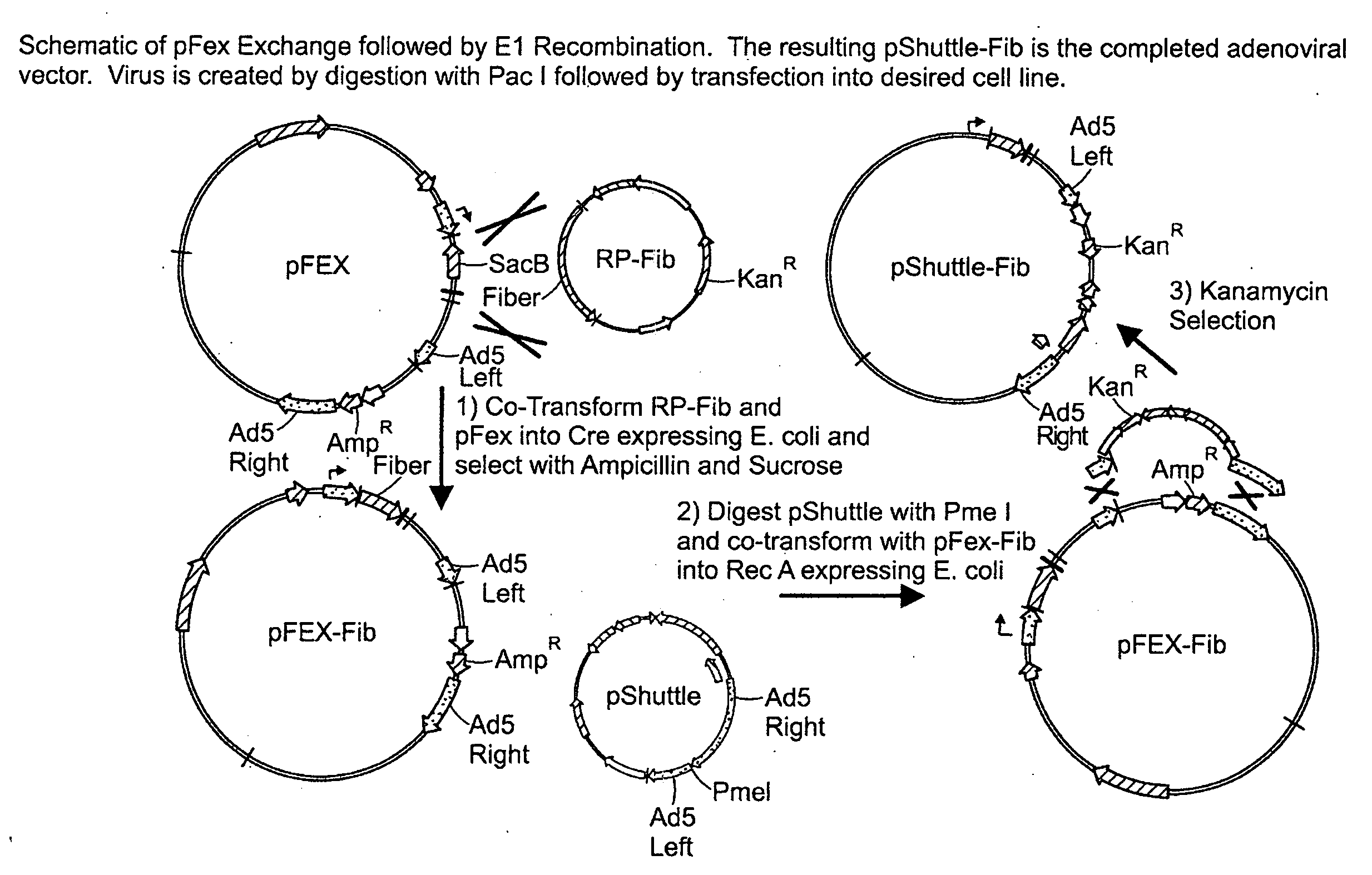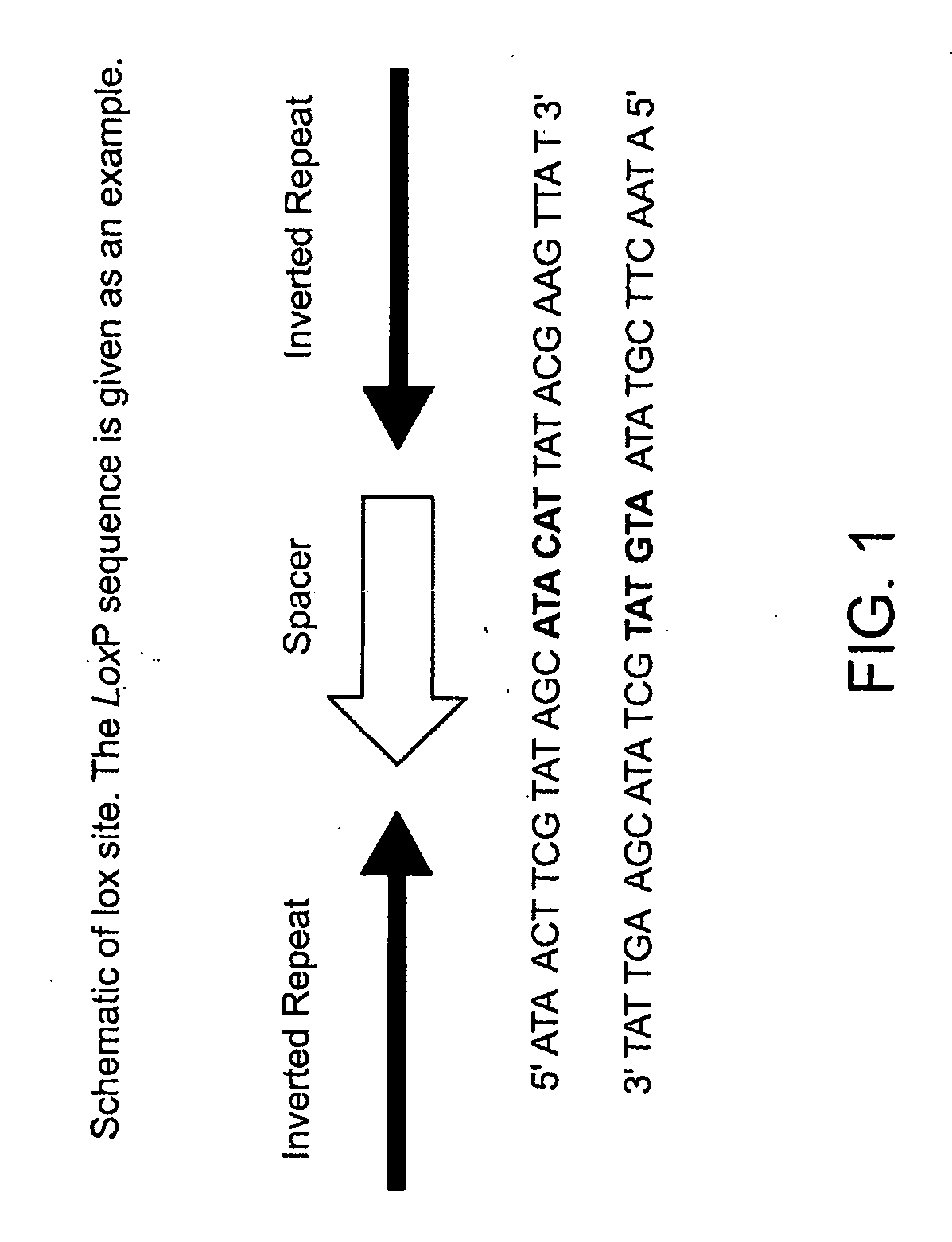Compositions and methods for generating and screening adenoviral libraries
a technology of adenoviral libraries and adenoviral vectors, which is applied in the field of compositions and methods for generating and screening adenoviral libraries, can solve the problems of hampered use of adenoviral vectors as therapeutic agents
- Summary
- Abstract
- Description
- Claims
- Application Information
AI Technical Summary
Benefits of technology
Problems solved by technology
Method used
Image
Examples
example 1
Vector Strategy
[0167]The Cre recombinase from bacteriophage P1 is an enzyme which mediates the excision and integration of DNA based on specific sequence binding sites (lox) through stepwise cleavage and ligation involving Holiday Junction intermediates (Ghosh, K. and Van Duyne, G. D. (2002) Methods, 28: 374-383). Though nearly 100 related tyrosine recombinases have been identified by sequence homology, Cre recombinase is among the best studied. Lox binding sites are 34 base pairs in length, but are solely sufficient to target Cre binding and recombination with the corresponding Lox sites. The canonical Lox site is the LoxP site. It has a 13 bp inverted repeat and an 8 bp spacer (FIG. 1). The 8 bp spacer is asymetrical and hence has orientation (actual direction of arrow is arbitrary). Two-loxP sites flanking a gene are called “floxing”. If a gene is floxed by two identical sites facing the same direction, it will be deleted with Cre recombinase. If a gene is floxed by Lox sites fac...
example 2
Design and Methods for Producing pFex Components
[0171]pFex was assembled through several steps. First, a segment called ‘distal to fiber Age I’ was created by PCR amplification of the adenovirus serotype 5 genome with primers AdE-Dist 5′ and AdE-Dist 3′ (FIG. 23). This product was then cloned into the TOPO-TA vector pCR-2.1, using TA cloning, to produce the vector Step 1 pFex (FIG. 6).
[0172]Second, a segment called ‘proximal to fiber’ was created by PCR amplification of the adenovirus serotype 5 genome with primers loxmve1 and loxmve2 (FIG. 23). This product was then cloned into Step 1 pFex using the Spe I and Age I restriction sites. The resulting vector is Step 2 pFex (FIG. 7).
[0173]The SacB gene was isolated from the vector pAJ200 using the Bgl II and Pvu I restriction sites. Next, the two half mutant lox sites, lox m2 / 66 and lox 71, were added by ligation with self annealed linkers 5′ lox m2 / 66 and 3′ lox m2166, and 5′ lox 71, and 3′ lox 71, respectively (FIG. 23). The resulting...
example 3
Design of the Vector System
[0177]A novel vector system was generated for modifying the Fiber-gene region of the widely applied Adenovirus vector, pAdEasy-1 (He et al., Proc Natl Acad Sci USA, 95, 2509-2514). The vector system, outlined in FIG. 14, applies an “acceptor” vector, pFex, and Fiber “donor” vectors, RP-FBR or RPuc-FBR (depending on required antibiotic). The pFex acceptor vector is a modified version of AdEasy-1, where the Fiber gene and upstream tripartite leader (TPL) splice-acceptor-site (Ad5 nucleotides 31,023-32,768) have been replaced with the Bacillus subtilis (SacB) gene. SacB imparts negative selectivity to bacteria grown in 5% sucrose and thus offers a means to negatively select against non-recombined acceptor vectors (Pierce et al., Proc Natl Acad Sci USA, 89, 2056-206). Correspondingly, the donor vectors contain the modified fiber gene, TPL splice acceptor site, and regions for additional transgene incorporation. Both donor and acceptor gene cassettes are flanke...
PUM
| Property | Measurement | Unit |
|---|---|---|
| temperatures | aaaaa | aaaaa |
| temperatures | aaaaa | aaaaa |
| temperatures | aaaaa | aaaaa |
Abstract
Description
Claims
Application Information
 Login to View More
Login to View More - R&D
- Intellectual Property
- Life Sciences
- Materials
- Tech Scout
- Unparalleled Data Quality
- Higher Quality Content
- 60% Fewer Hallucinations
Browse by: Latest US Patents, China's latest patents, Technical Efficacy Thesaurus, Application Domain, Technology Topic, Popular Technical Reports.
© 2025 PatSnap. All rights reserved.Legal|Privacy policy|Modern Slavery Act Transparency Statement|Sitemap|About US| Contact US: help@patsnap.com



